Caprification: A unique relationship between ... - uri=ucce.ucdavis
Caprification: A unique relationship between ... - uri=ucce.ucdavis
Caprification: A unique relationship between ... - uri=ucce.ucdavis
You also want an ePaper? Increase the reach of your titles
YUMPU automatically turns print PDFs into web optimized ePapers that Google loves.
3-ha field site selected to evaluate the salt<br />
tolerance of corn on Delta organic soil. It is<br />
located on the Marian Fry farm on Terminous<br />
Tract, San Joaquin County. The<br />
soil, about 2 meters deep, is typical of the<br />
Delta soils in composition and uniformity.<br />
The experimental design, shown schematically<br />
in figure 2, consists of 5 sprinkler-irrigated<br />
treatments replicated 6 times and 4<br />
subirrigation treatments replicated 4 times.<br />
The sprinkler treatments are irrigated with<br />
low-level sprinklers to provide uniform<br />
water applications with ample leaching. The<br />
resultant soil salinity profiles should<br />
simulate those in standard salt tolerance<br />
trials so that the results can be compared<br />
with those from trials of other crops. The<br />
subirrigation treatments are similar to the<br />
commonly accepted irrigation practices for<br />
corn in the Delta. Comparison of the two<br />
systems provides the means to evaluate any<br />
differences in salt tolerance because of the<br />
irrigation method.<br />
The salinity levels of the water used in the<br />
5 sprinkler treatments are 0.2, 0.6,1.0, 2.0,<br />
3.0 dS/m. The levels for the 4 subirrigation<br />
treatments are the same except that the 3.0<br />
dS/m treatment is omitted. Water for the<br />
least saline treatment is taken directly from<br />
the south fork of the Mokelumne River.<br />
During the growing season, the river water<br />
has an average electrical conductivity of<br />
about 0.2 dS/m and a chloride concentration<br />
of nearly 10 mg/l. The remaining water<br />
treatments are prepared by mixing the river<br />
water with saline well water. The well, drilled<br />
near the experiment, delivers water having<br />
an EC of 8.1 dS/m and a chloride concentration<br />
of 2200 mg/l.<br />
Irrigation treatments<br />
The sprinklered plots are irrigated weekly<br />
to meet the evapotranspirational demand of<br />
the crop plus about 50 percent additional<br />
water for leaching. This maintains fairly<br />
uniform soil salinity throughout the root<br />
zone. Leaching is possible in the sprinkler<br />
plots because we installed subsurface drains<br />
on a 15-m spacing at a depth of 2 m. The<br />
subirrigation treatments are irrigated 3<br />
times during the season to raise the water<br />
table to within about 0.1 m of the soil surface.<br />
Land preparation, planting, fertilization,<br />
and cultivation are performed by the farmer<br />
and they match those for corn grown in the<br />
area. One of the typical corn varieties,<br />
DeKalb XL 75, is being grown. Yields will<br />
be determined by hand harvesting the<br />
center portion of each plot. In addition to<br />
grain yield, plant density, plant height, and<br />
stover weight will be determined and correlated<br />
with soil salinity measurements.<br />
This three-year study, supported in part<br />
by the California State Water Resources<br />
Control Board and the California Department<br />
of Water Resources, is in its initial<br />
year. It will be finished, however, before<br />
the water quality standards in the Delta are<br />
reevaluated in 1982.<br />
G.J. Hojjtnun and E. V. Muas are with the U.S. Salinit!<br />
Laborutory, USDA/SEA-AR, Riverside. Jewel1 L.<br />
Meyer and Terry L. Prichard are Soil and Wutiv<br />
Specialists, U. C. Cooperative Extension. Donald R.<br />
Lancaster is Staff Research Assistant, U. C. Cooperati<br />
ve Extension.<br />
Capri f icat ion:<br />
A <strong>unique</strong> <strong>relationship</strong><br />
<strong>between</strong> plant and insect<br />
Marvin Gerdts 0 Jack Kelly Clark<br />
By transferring pollen from<br />
inedible caprifgs to edible<br />
Smyrna-types, a tiny wasp<br />
helps create an important<br />
com mercial crop.<br />
I n California, the fig, like many other<br />
fruits, was introduced when the mission at<br />
San Diego was established in 1769. Commercial<br />
culture started in 1885 and dried<br />
Adriatic figs were shipped east in 1889; but<br />
these were inferior in eating quality to imported<br />
Smyrna-type figs. Smyrna figs,<br />
which require pollination to set fruit, were<br />
introduced into California in 1881-1882,<br />
but it was not until about 1900-through<br />
the efforts of George Roeding of Fresno<br />
and L. 0. Howard and Walter Swingle of<br />
the USDA-that the fig wasp, Blastophaga<br />
psenes L., was established and used successfully<br />
to transfer caprifig pollen to<br />
Smyrna-type figs to obtain fruit-set (a<br />
process called “caprification”). This success<br />
stimulated interest in commercial production<br />
of Calimyrna (Sari Lop, California<br />
Smyrna) figs in California, and acreage expanded<br />
in the early 1900s.<br />
Pollination of Calimyrna figs involves<br />
complex symbiotic <strong>relationship</strong>s <strong>between</strong><br />
caprifigs and the fig wasp. Over the years,<br />
University of California researchers have<br />
investigated and described these <strong>relationship</strong>s.<br />
They have also studied methods of<br />
using fig wasps in the commercial production<br />
of Calimyrna figs, while insuring that<br />
the crop is protected from fruit diseases<br />
that can be transmitted by Blastophaga.<br />
Gustav Eisen described the fig wasp life<br />
cycle and its <strong>relationship</strong> to caprifigs in<br />
1901. Ira Condit, U.C. Subtropical Horticulturist,<br />
added further descriptions in<br />
1918 and 1920. Their descriptions of<br />
caprification, a horticultural word used to<br />
describe the pollination process in figs, illuminated<br />
the complex <strong>relationship</strong>s of<br />
plant and insect.<br />
<strong>Caprification</strong><br />
The fig fruit is a hollow peduncle bearing<br />
numerous pistillate (female) flowers on the<br />
inner wall. For Calimyrna fruits to mature,<br />
12 CALIFORNIA AGRICULTURE. NOVEMBER-DECEMBER 1979
Fertilized female wasp emerges from a gall flower in the<br />
caprifig (17.6~ life-size).<br />
these flowers must be pollinated from an<br />
external source, and nature has provided<br />
the very specialized fig wasp to transfer<br />
pollen from the male caprifig to Calimyrna<br />
fruits. Without caprification, Calimyrna<br />
figs grow to Yi to ?4 inch in diameter and<br />
then turn yellow, shrivel, and drop before<br />
maturing.<br />
The caprification process occurs from<br />
the end of May into June. Adult female<br />
wasps emerge from caprifigs and enter<br />
Calimyrna figs, seeking egg-laying sites. In<br />
the process, pollen carried on the wasp<br />
bodies is spread to female flowers and results<br />
in fertilization and the production of<br />
viable seeds. Eggs are not laid in female<br />
flowers of Calimyrna figs because the<br />
flower structure is not suited to oviposition<br />
by the wasp.<br />
The fig wasp relies on caprifigs to reproduce<br />
and complete its life cycle. It completes<br />
three life cycles per year, coinciding<br />
with the three caprifig crops: profichi<br />
(spring) crop; mammoni (summer) crop;<br />
and mamme (winter) crop. Female adults<br />
emerge from maturing caprifigs seeking<br />
egg-laying sites in the succeeding overlapping<br />
crop. They proceed by seeking Caprifigs,<br />
which they enter to deposit eggs on<br />
modified female flowers (gall flowers)<br />
suited to fig-wasp egg laying. In the ovaries<br />
of these flowers, the larvae hatch and develop.<br />
Adult male wasps emerge from the<br />
gall flowers first and fertilize the females<br />
before they leave the galls. After mating,<br />
adult female wasps migrate in search of thc<br />
succeeding caprifig crop and the cycle continues.<br />
Further studies<br />
U.C. Plant Pathologist P. D. Cddis described<br />
an internal fig rot problem in 1925<br />
and 1927. He suggested the name endosepsis<br />
for the fungus disease caused by Fusarium<br />
moniliforme (Sheld.) Snyder and Han-<br />
CALIFORNIA AGRICULTURE, NOVEMBER.DECEMBER 1979 13
Caprifigs are placed in<br />
slotted paper bags in<br />
Calimyrna orchards.<br />
Female wasps that<br />
emerge from these figs<br />
will enter the edible<br />
Calimyrna figs in<br />
search of suitable egglavina<br />
sites.<br />
Female wasp emerges from the eye of a caprifig. She will then fly<br />
to another fig to lay her eggs (15x life-size).<br />
Female wasD enters the eve of acalimvrna fia (17x life-size).<br />
sen. Caldis found the fungus in caprifigs<br />
and showed that it was transmitted to Calimyrna<br />
figs by the fig wasp.<br />
Treatment to control endosepsis was developed<br />
by H. N. Hansen, another U.C.<br />
Plant Pathologist. In a series of investigations<br />
beginning in 1926 he developed a<br />
caprifig dipping technique which is still<br />
used by the fig industry.<br />
From 1944 through 1946 Simmons and<br />
Fisher (USDA), Condit and Hansen<br />
(U.C.), and Tyler (California Fig Institute)<br />
researched caprification procedures. They<br />
determined the number of wasp-egg laden<br />
caprifigs needed per Calimyrna tree, the<br />
best distribution pattern of caprifigs within<br />
a Calimyrna orchard, the frequency of<br />
caprifig distribution, and the number of<br />
times caprifigs should be distributed during<br />
the caprification season. The studies resulted<br />
in standardization of caprification<br />
schedules and provided guidelines that in-<br />
sured crop-set while minimizing disease<br />
and fruit-split.<br />
By 1950, Robert Warner (California Fig<br />
Institute and U.C.) described refinements<br />
of Hansen’s endosepsis clean-up program.<br />
As mercuric fungicides had to be replaced,<br />
other fungicides were tested and recommended<br />
by U.C. Food Technologist M. W.<br />
Miller and Gerdts and Obenauf of U.C.<br />
Cooperative Extension in the late 1960s<br />
and early 1970s. Fungicide studies were<br />
again resumed in 1977 by Obenauf and<br />
U.C. Plant Pathologist J. M. Ogawa as additional<br />
disease problems were encountered.<br />
U.C. researchers continue the search for<br />
ways to best utilize the fig wasp to enable<br />
California growers to produce abundant,<br />
high-quality figs.<br />
Marvin Gerdts was formerly Extenyion PomoloRist,<br />
U. C., San Joaquin Valley Agricultural Research and<br />
Extension Center, Parlier; andJack Kelly Clark i\ Senior<br />
Photographer, Cooperative Extension, U. C., Davis.<br />
Female wasps try to lay their eggs in female<br />
flowers inside the Calimyrna fig but fail because<br />
the styles are too long. While struggling<br />
to lay their eggs, the wasps transfer<br />
pollen to the flowers, thus ensuring fruit-set<br />
(14x life-size).<br />
14 CALIFORNIA AGRICULTURE, NOVEMBER-DECEMBER 1979
















![Fig Trees in North Carolina [Archive] - IDigMyGarden ... - Figs 4 Fun](https://img.yumpu.com/26905320/1/190x245/fig-trees-in-north-carolina-archive-idigmygarden-figs-4-fun.jpg?quality=85)